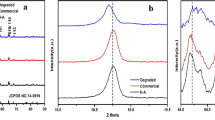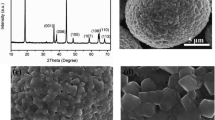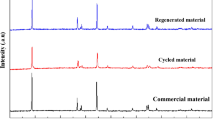Abstract
This paper mainly aims at recycling the spent lithium-ion battery. The process is very innovative, simple, and feasible. It directly regenerates the degraded cathode material NCM613. In the air atmosphere, the low eutectic mixture LiNO3-LiOH is used as lithium salt for lithium supplements. The results of ICP, XRD, and SEM show that the components and crystal structure of the degraded cathode material can be regenerated to the pristine. The electrochemical results show that the discharge capacity can reach 175.25 mAh/g (0.1 C), and the charge–discharge coulomb efficiency is 87.8%. After 1000 cycles under the condition of 1 C, the capacity retention rate is 94.5%. Compared with the degraded cathode material, the cycling performance is greatly improved, which is similar to the Pristine NCM613 material. This research provides a unique idea for the green recycling of lithium batteries.






Similar content being viewed by others
References
Weigel T, Schuipper F, Evan M et al (2019) Structural and electrochemical aspects of LiNi0.8Co0.1Mn0.1O2 cathode materials doped by various cations. ACS Energy Lett 4:508–516
Shi Y, Chen G, Liu F et al (2018) Resolving the compositional and structural defects of degraded LiNixCoyMnzO2 particles to directly regenerate high performance lithium-ion battery cathodes. ACS Energy Lett 3:1683–1692
Park KJ, Hwang JY, Ryu HH et al (2019) Degradation mechanism of Ni-enriched NCA cathode for lithium batteries: are microcracks really critical? ACS Energy Lett 4:1394–1400
Kevin M, Steven J, Timothy G et al (2018) A review on the growing concern and potential management strategies of waste lithium-ion batteries. Conserv Recycl 129:263–277
Yan PF, Zheng JM, Tang ZK et al (2019) Injection of oxygen vacancies in the bulk lattice of layered cathodes. Nat Nanotechnol 15:602–608
Sun HH, Manthiram A (2017) Impact of microcrack generation and surface degradation on a nickel-rich layered LiNi0.9Co0.05Mn0.05O2 cathode for lithium ion batteries. Chem Mater 29:8486–8493
Zhao R, Liang J, Huang J, Zeng R, Zhang J, Chen H, Shi G (2017) Improving the Ni-rich LiNi0.5Co0.2Mn0.3O2 cathode properties at high operating voltage by double coating layer of Al2O3 and AlPO4. J Alloys Compd 724:1109–1116
Yoon CS, Kim UH, Park GT, Kim SJ, Kim KH, Kim J, Sun YK (2018) Self-passivation of a LiNiO2 cathode for a lithium ion battery through Zr doping. ACS Energy Lett 3:1634–1639
Shiiba H, Zettsu N, Kida S, Kim D, Teshima K (2018) Impact of trace extrinsic defect formation on the local symmetry transition in spinel LiNi0.5Mn1.5O4 systems and their electrochemical characteristics. J Mater Chem A 6:22749–22757
Kasnatscheew J, Evertz M, Streipert B et al (2017) Changing established belief on capacity fade mechanisms: thorough investigation of LiNi1/3Co1/3Mn1/3O2 (NCM111) under high voltage conditions. J Phys Chem C 121:1521–1529
Yoon CS, Jun DW, Myung ST, Sun YK (2017) Structural stability of LiNiO2 cycled above 4.2 V. ACS Energy Lett 2:1150–1155
Zhao TY, Song YF, Li YL, Zhao ZW, He LH, Chen XY, Liu XH (2019) Recovery of lithium from leaching solution of anode materials in waste lithium-ion batteries by solvent extraction method. Nonferrous Metals Science and Engineering 10:49
Gao WF, Song JL, Cao HB, Lin X, Zhang XH, Zheng XH, Zhang Y, Sun Z (2018) Selective recovery of valuable metals from spent lithium-ion batteries-process development and kinetics evaluation. J Clean Prod 178:833
Chen XP, Guo CX, Ma HR, Li JZ, Zhou T, Cao L, Kang DZ (2018) Organic reductants based leaching: a sustainable process for the recovery of valuable metals from spent lithium ion batteries. Waste Manage 75:459
Roy JJ, Madhavi S, Cao B (2021) Metal extraction from spent lithium-ion batteries (LIBs) at high pulp density by environmentally friendly bioleaching process. J Clean Prod 280:124242
Wu J, Lin J, Fan E et al (2021) Sustainable regeneration of high performance Li1-xNaxCoO2 from cathode materials in spent lithium ion batteries. ACS Applied Energy Materials 4:2607–2615
Zhang HM, Huang JY, Hu RH et al (2020) Echelon utilization of waste power batteries in new energy vehicles: review of Chinese policies. Energy 206:118178
Shi Y, Chen G, Liu F et al (2018) Resolving the compositional and structural defects of degraded LiNixCoyMnzO2 particles to directly regenerate high-performance lithium ion battery cathodes. ACS Energy Lett 3:1683–1692
Gao RC, Sun CH, Xu LJ, et al (2020) Recycling LiNi0.5Co0.2Mn0.3O2 material from spent lithium-ion batteries by oxalate co-precipitation. Vacuum 173: 109181
Funding
This project was supported by the science and technology project of State Grid Zhejiang Electric Power Co., Ltd. (5211UZ2000K1).
Author information
Authors and Affiliations
Corresponding author
Additional information
Publisher's note
Springer Nature remains neutral with regard to jurisdictional claims in published maps and institutional affiliations.
Rights and permissions
Springer Nature or its licensor holds exclusive rights to this article under a publishing agreement with the author(s) or other rightsholder(s); author self-archiving of the accepted manuscript version of this article is solely governed by the terms of such publishing agreement and applicable law.
About this article
Cite this article
Guan, M., Chen, X., Lou, P. et al. Regeneration of degraded cathode materials from spent LIBs via eutectic solutions. Ionics 28, 5469–5474 (2022). https://doi.org/10.1007/s11581-022-04749-3
Received:
Accepted:
Published:
Issue Date:
DOI: https://doi.org/10.1007/s11581-022-04749-3




